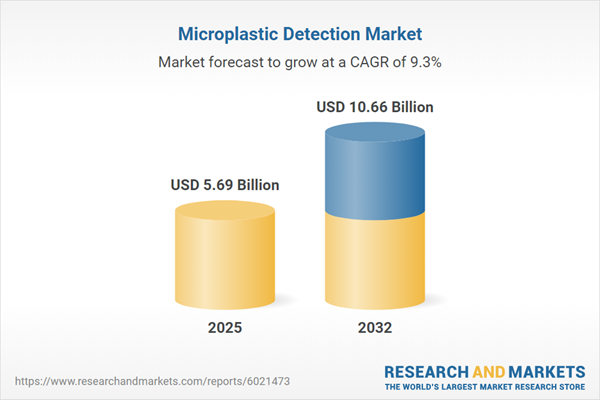Speak directly to the analyst to clarify any post sales queries you may have.
The global microplastic detection market is entering a phase of rapid advancement, driven by regulatory scrutiny, cross-industry collaboration, and the adoption of precision technologies for environmental and public health protection. Senior decision-makers are prioritizing resilient strategies and innovative solutions to address growing microplastic contamination across diverse applications.
Market Snapshot: Microplastic Detection Market Growth and Outlook
The microplastic detection market grew from USD 5.23 billion in 2024 to USD 5.69 billion in 2025. This robust expansion is expected to continue at a CAGR of 9.30%, with the market anticipated to reach USD 10.66 billion by 2032. Surging environmental concerns, evolving regulatory standards, and investment in high-performance analytical instruments are fueling demand across regions and industries.
Scope & Segmentation
This report provides a detailed analysis of how the microplastic detection market is structured, focusing on critical segmentation to inform procurement and investment decisions:
- Technology: Mass spectrometry, microscopy (optical, scanning electron, transmission electron), spectroscopy (Fourier transform infrared, laser-induced breakdown, near-infrared, Raman), X-ray microcomputed tomography
- Plastic Types: Acrylic, polyamide, polyethylene, polyethylene terephthalate, polylactic acid, polypropylene, polystyrene, polytetrafluoroethylene, polyurethane, polyvinyl chloride
- Source: Non-synthetic polymers, synthetic polymers
- Detection Instrumentation: Desktop analyzers, in-situ analyzers, portable handheld devices
- Size Range: 1 mm – 3 mm, 3 mm – 5 mm, less than 1 mm
- Application: Cosmetics and personal care (creams and lotions, toothpaste), food and beverage (bottled beverages, packaged foods, seafood), pharmaceuticals (ingredient testing, product contamination assessment), water treatment (drinking water, marine water, wastewater)
- End-Users: Academic and research institutes, chemical and material manufacturers, consumer goods manufacturing, government and regulatory bodies
- Regions: Americas (United States, Canada, Mexico, Brazil, Argentina, Chile, Colombia, Peru), Europe, Middle East & Africa (UK, Germany, France, Russia, Italy, Spain, Netherlands, Sweden, Poland, Switzerland, UAE, Saudi Arabia, Qatar, Turkey, Israel, South Africa, Nigeria, Egypt, Kenya), Asia-Pacific (China, India, Japan, Australia, South Korea, Indonesia, Thailand, Malaysia, Singapore, Taiwan)
- Companies: Agilent Technologies, Bruker Corporation, Bureau Veritas, Carl Zeiss, Danaher, Eurofins Scientific, SOCOTEC, HORIBA, IEH Laboratories, Intertek, JASCO, JEOL, Measurlabs, Metrohm, NEC Corporation, Ocean Diagnostics, Oxford Instruments, Renishaw, Revvity, SGS, Shimadzu, Spectris, Tame-Water by Alcen, TESCAN GROUP, Thermo Fisher, TUV SUD, Wasser 3.0 gGmbH
Key Takeaways for Senior Decision-Makers
- Advancements in high-resolution imaging and AI-powered spectroscopy are enabling faster, more accurate microplastic detection across commercial and research environments.
- Regulatory harmonization and international standard-setting are shaping consistent detection procedures, which support reliable benchmarking and compliance strategies.
- Industry stakeholders increasingly rely on modular instrumentation and localized manufacturing to manage procurement risks and supply chain volatility.
- Comprehensive detection coverage includes water, food, cosmetics, and pharmaceuticals, offering holistic monitoring for critical exposure pathways.
- Emerging collaborations between public agencies, academia, and manufacturers accelerate the validation and deployment of innovative detection protocols.
- Competitive differentiation now focuses on end-to-end solutions integrating instrumentation, cloud-based analytics, and real-time monitoring capabilities.
Tariff Impact: United States 2025 Supply Chain Dynamics
Recent import levies on laboratory instruments and components in the United States have increased acquisition costs and added complexity to procurement decisions. Extended procurement cycles have led end-users to consider domestic partnership and alternative sourcing strategies, accelerating localized production for core analytical modules. Vendors are responding with bundled services and enhanced maintenance, balancing near-term challenges while fostering innovation in modular system design and supporting initiatives for domestic production incentives.
Methodology & Data Sources
This analysis uses a robust combination of primary interviews with laboratory directors, environmental regulators, engineers, and scientists, alongside comprehensive secondary research. Data triangulation ensures alignment of expert insight with industry shipment reports, peer-reviewed publications, and white papers, while multi-stage validation reinforces the integrity of all findings.
Why This Report Matters
- Supports strategic investment in emerging microplastic detection technologies with granular market segmentation and validated forecasting.
- Enables benchmarking against regulatory and technological trends, facilitating risk mitigation and long-term procurement planning.
- Empowers leadership with actionable insights on regional, technology, and end-use dynamics to capture competitive advantage.
Conclusion
The microplastic detection market is shaped by technology, regulation, and global collaboration. Leaders who adapt to shifting market forces and invest in scalable solutions position themselves to address evolving microplastic challenges across industries.
Additional Product Information:
- Purchase of this report includes 1 year online access with quarterly updates.
- This report can be updated on request. Please contact our Customer Experience team using the Ask a Question widget on our website.
Table of Contents
3. Executive Summary
4. Market Overview
7. Cumulative Impact of Artificial Intelligence 2025
Companies Mentioned
The companies profiled in this Microplastic Detection market report include:- Agilent Technologies, Inc.
- Bruker Corporation
- Bureau Veritas SA
- Carl Zeiss AG
- Danaher Corporation
- Eurofins Scientific SE
- HOLDING SOCOTEC - S.A.S.
- HORIBA, Ltd.
- IEH Laboratories and Consulting Group
- Intertek Group PLC
- JASCO Corporation
- JEOL Ltd.
- Measurlabs
- Metrohm AG
- NEC Corporation
- Ocean Diagnostics Inc.
- Oxford Instruments PLC
- Renishaw PLC
- Revvity, Inc.
- SGS S.A.
- Shimadzu Corporation
- Spectris PLC
- Tame-Water by Alcen SAS
- TESCAN GROUP, A.s.
- Thermo Fisher Scientific Inc.
- TUV SUD AG
- Wasser 3.0 gGmbH
Table Information
| Report Attribute | Details |
|---|---|
| No. of Pages | 190 |
| Published | November 2025 |
| Forecast Period | 2025 - 2032 |
| Estimated Market Value ( USD | $ 5.69 Billion |
| Forecasted Market Value ( USD | $ 10.66 Billion |
| Compound Annual Growth Rate | 9.3% |
| Regions Covered | Global |
| No. of Companies Mentioned | 28 |









